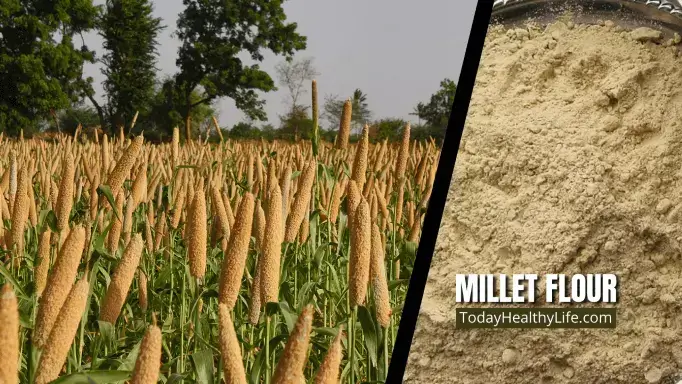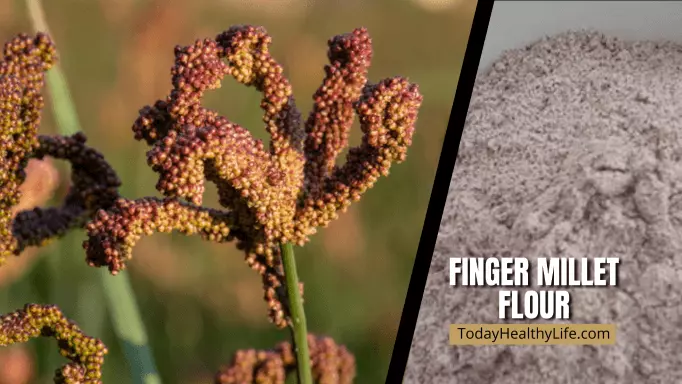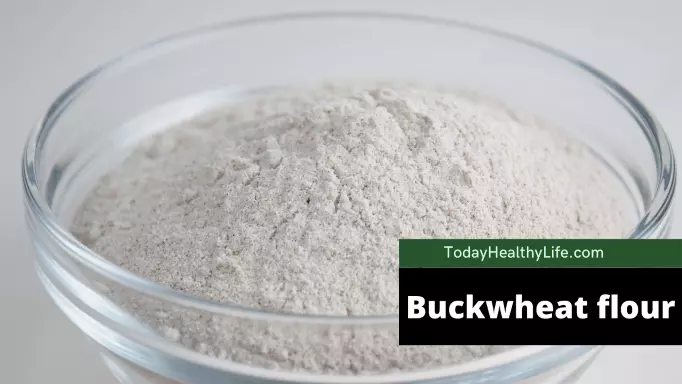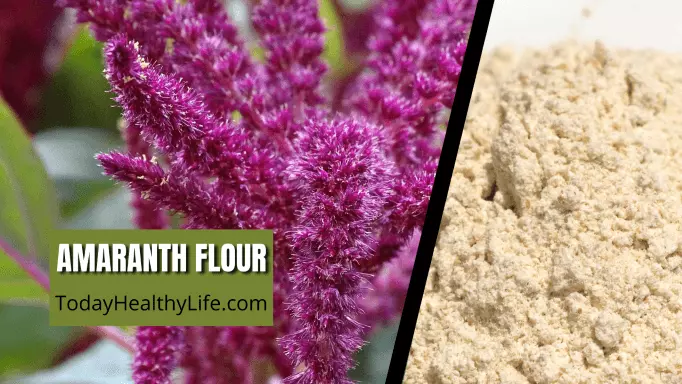Millet flour is a great alternative to your regular white bread. Recently Millet flour has become a more popular ingredient for many dishes for its nutritional properties and accompanying health benefits. Though the concept of millet isn’t a new one as a wholesome alternative to rice or potatoes. Actually, it is the oldest cultivated cereal.
Table of Contents
What is millet flour?

Millet flour is flour that comes from millet seed. Millets are the minor cereal grain that comes from the grass family. About the 1990s when it was popularised to a significant degree by trending western macrobiotic vegetarianism. Millet flour is highly nutritious and you should include them in your daily diet as available.
Archaeologists found that people have been consuming millet for over four thousand years. It has a mildly sweet nutty flavor that makes it good to incorporate, side dishes, traditional dishes, and desserts as well. It is also a relatively inexpensive variation as well as a quick-cooking variety that only takes about 25 to 30 minutes.
Millet flour is a nutritious flour with good taste. It has fiber, B vitamins, iron, and some minerals as well. Most importantly it’s gluten-free and really is yummy.
Is millet flour gluten free?
Yes, in its natural form, millet flour is gluten-free. Millet flour is used in a wide variety of ways; these small seeds are harvested for grains. You can make versatile and diverse dishes with millet grains, Like flatbreads, porridges, drinks, pilafs, bread, and more. You can make alcoholic beverages such as millet beer.
However, you have to always be careful when purchasing any millet products that are truly gluten-free before consuming. Many grains contain high-risk gluten such as wheat, barley, and rye.
Also read: Is corn starch gluten free? Why do females eat it, & more.
– What is corn flour, nutrition, benefits, substitute, is corn flour gluten free?
– Spelt flour substitute | Is Spelt flour gluten free?
Types of Millet Flour
According to the size and shape of millet seed, there are different types of millet flour, such as-
Pearl Millet Flour
In winter when your body needs extra warming energy, you can consume pearl millet. It is also highly nutritious.
Foxtail Millet Flour
Foxtail Millet contains highly effective iron and also contains blood sugar balancing carbo-hydrates.
Barnyard Millet Flour
Barnyard Millet Flour tastes good and it’s nutritious too. It has fiber, B vitamins. Barnyard Millet is easy to digest compared to other millet.
Finger Millet Flour

Another most common gluten-free and protein-rich millet flour is finger millet flour which is also known as ragi flour. Ragi flour is very helpful for developing the brain of children.
Read the details: What is finger millet flour? nutrition, benefits & side effects.
Little Millet Flour
This type of millet seed is somewhat smaller than other types of millet. Little millet flour is rich in fiber, vitamins, minerals, and antioxidants. This flour is the best option for those who want to lose weight.
Millet Flour Substitute
As a flour or grain replacement, millet might be one to include in your pantry along with other gluten-free favorites like rice quinoa, buckwheat, sorghum, and amaranth. These are the grains you can use for any baking recipe.
Buckwheat flour

Although it has wheat in its name, don’t worry it’s gluten-free. Its small grain has a greenish and gray color with a little bit nuttier flavor than regular flour.
It has various health benefits and has become a sensation grain flour for a nutritious diet. It contains low GI, low carb, and high in proteins.
Sorghum flour
Sorghum flour is also gluten-free. Sorghum flour and Millet flour are often used to mix by nutrition for various healthy dishes. It has a mildly sweet flavor and a smooth texture. Furthermore, it binds co2 moisture and co2 bubbles in bread making.
Amaranth flour

As a grain Amaranth looks like a tinier version of Quinoa. It is also a gluten-free new world grain. It was a staple of Inca and Aztec diets. Amaranth is loaded with nutrition. A half-cup of cooked amaranth contains 4.7 grams of protein.
Why Gluten-Free Millet Flour Best for Diet
Millet has a gluten-free alternative to rye, barley, and wheat-based foods. Gluten is a type of protein that’s not tolerated by those with gluten sensitivities or celiac disease. While many people don’t experience major health issues after consuming glutinous foods. Some may feel very less frazzled with good digestion while maintaining a gluten-free diet.
As a flour or grain replacement millet might be one to include in your pantry along with other gluten-free favorites like quinoa, buckwheat, sorghum, amaranth, and teff.
Millet flour Nutrition
Millet flour’s nutritious value is surprisingly high. It contains a good amount of fiber as well as containing 17 milligrams of calcium, 4.7 milligrams of iron, 4.8 milligrams of sodium, 267 milligrams of potassium, 13 grams protein, 89 grams carbohydrates, and 5.1 grams fat in every 119gram millet flour. This amount of millet flour delivers 455 calories.
| Nutrient (every 119 gram) | Nutritional Value |
| Calcium | 17 milligrams |
| Sodium | 4.8 milligrams |
| Potassium | 267 milligrams |
| Protein | 13 grams |
| Carbohydrates | 89 grams |
| Fat | 5.1 grams |
Finger millet flour’s nutritious value is surprisingly high. It contains a good amount of fiber as well as maintains 344 calcium iron on every 100 grams. But on Proso and Pearl Millet, it got 14 and 38 milligrams of calcium iron per 100 grams. So anyone who needs to have calcium on the body can have Finger Millet.
Browntop millet, Barnyard millet, Kodo millet, and foxtail millet contain a good amount of fiber as well as maintain a good amount of carbohydrate and calcium too. The fiber and carbohydrate ratio of this millet is well below ten. This factor categories them as golden millets.
HOMEMADE MILLET FLOUR’S INGREDIENTS AND EQUIPMENT NEEDED –
- Drinking water
- Millet flour that is gluten-free
- Dates
- A bag of milk
- Cinnamon powder
- Extract of vanilla
- Salt
- high-speed blender- if you have elevated
blender, then it is better. But if you don’t then you can use an electric mixer instead
- A huge jug or a bowl
- A container in which to preserve your Millet Flour
If you’ve ever prepared porridge or Millet flour, you’re definitely aware that Millet flour produces a sweet and savory taste consistency, which is fantastic for breakfast but not so great for making wonderfully velvety.
These bread recipe steps are rather straightforward:-
- Combine the Millet and water in a medium mixing basin. Close the cover and soak water for at least 30 minutes, for up to several hours.
- Only after the Millet has dried, mix it with the water in a high-powered blender and blend until the Millet and water are completely incorporated.
- Pour the Millet into a blender with your milk within. Then blend your Millet with milk.
- Then you can finish compressing after you only have Millet flour pulp remaining in the blender. You may use this for your regular bread.
What is Millet used for?
Millet Flour can be used for versatile dishes. From breakfast to dinner it can be used in any dish as a replacement for other grains. It is most commonly used in Indian dishes as roti. You can make pasta, noodles, and pizza with Millet flour.
Benefits of Millet Flour
There are multiple advantages to using Millet flour in your dish than other grains. From celiac disease to celiac disease it can be useful. It also encourages a balanced gut microbiome.
Millet is Alkaline-enriched food that helps to reduce the risk factor of heart diseases. Besides, pathogenic yeast like Candida albicans does not get any nutrition from this flour.
This is why it is the most promoted grain on the body ecology diet. Millet flour is very beneficial for those who are infected with a candida infection. Furthermore, the soluble fiber in Millet plays a very important role in a prebiotic influence. It can support a good amount of yeast and bacteria in the intestinal microbiome.
Side Effects of Millet Flour
Excessive consumption of millet flour might cause excessive side effects to your health. That’s why you should consume your millet with a careful amount. Millets are safe when you consume this in a moderate amount.
Excessive consumption of millet can interfere with the production of thyroid hormones and inhibits iodine uptake and utilization by the thyroid gland. The deficiency of iodine is a significant health problem that leads to an enlarged thyroid gland, known as goiter.
Conclusion
Many millet flours contain gluten-free items, and millet flour is often used in gluten-free baking. For many individuals, Millet flour dishes are a beloved breakfast option.
Although there are numerous advantages to including millet in your gluten-free diet, it’s critical to purchase only gluten-free items that are labeled or verified as such. This guarantees that the millet remains unpolluted and clean.
